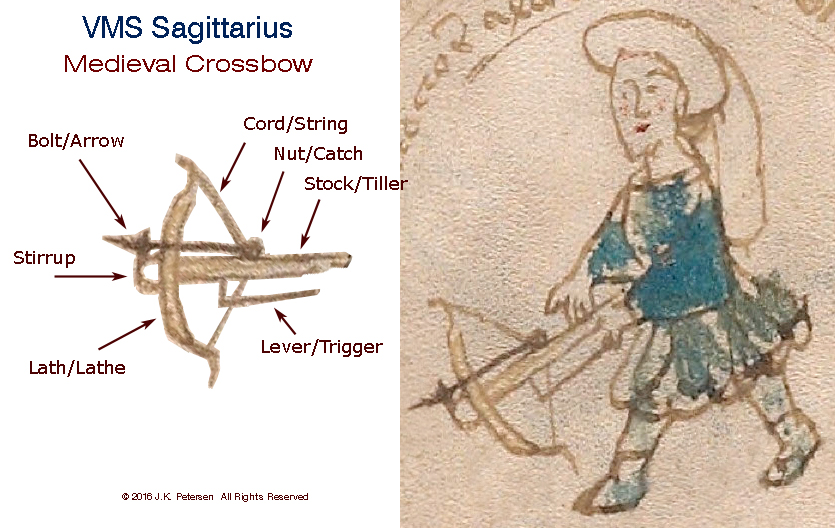Discussions about the Earliest Crossbow Sagittarius
There is currently an interesting (and lively) discussion about Voynich Manuscript history on K. Gheuen’s VoynichTemple site. I tried to post a long comment, but I’m not sure if it got through (maybe it was too long—several error messages popped up), so I’ve decided to expand it and post it with images as a blog instead.
This blog was inspired by the following comment:
“Nick: On Stephen’s site, Marco and Darren discuss a number of examples and the earliest crossbow-sagi-roundel is from Poland… https://stephenbax.net/?p=1656“
This is an easy mistake to make, even by good researchers like those mentioned. Political borders are constantly changing and sometimes it’s difficult to keep track of where they were at any particular point in history, but Österreichische Nationalbibliothek Cod. 1842, the earliest manuscript so far that depicts Sagittarius with legs and a crossbow, is not from Poland. It originates in Bohemia, in the Holy Roman Empire.
Some Background
The zodiac-symbol roundels are perhaps the most recognizable series of images in the VMS next to the plants, and I have always been interested in the history of astrology, so in 2014 and 2015, I was independently researching every Sagittarius with legs that I could find because I was used to seeing centaurs with longbows, not people with crossbows (I had also researched the other symbols but have posted them as separate articles).
In 2015, I superimposed my findings on a map of the Holy Roman Empire because that is where the majority of images originated. I searched far outside these borders (including Russia, Persia, India, north Africa, and the far-east because I am interested in zodiac imagery from around the world, but was not able to find anything similar to the VMS zodiacs outside of western Europe and the Levant.
The crossbow-Sagittarius map can be seen here.
The crossbow-Sagittarius mentioned by researchers on Bax’s site is listed by the Österreichichische Akademie der Wissenshaften as Cod. 1842, originating from Prague and Breslau (now known as Wroclaw). From 1335, Breslau was in the Kingdom of Bohemia. Even in 1386, the Kingdom of Bohemia stretched just beyond Olesnica, and Breslau was still well within its borders (the Bohemian Kingdom is sometimes also called Królestwo Czech—the Czech Kingdom).

For the half century that is most relevant to the creation of the Voynich Manuscript, Breslau/Wroclaw (300 km NE of Prague) was within the borders of the Bohemian/Czech Kingdom ruled by a German-born Bohemian King who also served as Holy Roman Emperor. [Underlying map detail courtesy of Wikipedia.]
During the search for crossbow-Sagittarius, and while gathering several hundred historic zodiac cycles, I found
- about eight Sagittarius with legs and a longbow (all within the Holy Roman Empire, with the exception of the Beit Alpha mosaic), and
- a dozen Sagittarius with legs and a crossbow, all within the Holy Roman Empire, and all except one (Cod. 1842 from Bohemia) were from Germany or very near the border between what we now call Switzerland and Germany.
Although I tried to locate crossbow-Sagittarius from a wider geographic distribution, I was not able to find any from Scandinavia, the Baltic, the British Isles, Italy, Russia, Georgia, Persia, Greece, Africa, Spain (I did have difficulty accessing some of the Spanish image browsers, so I don’t know whether I missed any Spanish zodiacs due to technical problems), or Asia. This is an ongoing project. If I see additional examples, I will update the map.
Political borders change. Other than the usual local skirmishes, there wasn’t much distinction between Bohemia and Germany during the long reign of Wenceslaus, HRE and King of Bohemia, so it’s difficult to argue that any of the crossbow-Sagittarius images found so far come from outside Germanic culture.
Crossbow-Sagittarius Details
 In my opinion, the crossbow itself is not drawn well enough to determine its origin. The only truly distinctive part is the long trigger (and maybe the recurved ends of the lath) and it’s hard to know whether the length of the trigger is literal, or a convenient way to draw it so it connects to the hand. It might be literal (the illustrator took time to draw the laces on the boots, a faint goatee, and the lacy edge on the sleeves of the Gemini female), but it’s a very tiny drawing, and the illustrator has difficulty with detailed structures like hands and rotating connections between body joints, so… even though all the basic parts are there, one has to wonder whether the finer details are accurate.
In my opinion, the crossbow itself is not drawn well enough to determine its origin. The only truly distinctive part is the long trigger (and maybe the recurved ends of the lath) and it’s hard to know whether the length of the trigger is literal, or a convenient way to draw it so it connects to the hand. It might be literal (the illustrator took time to draw the laces on the boots, a faint goatee, and the lacy edge on the sleeves of the Gemini female), but it’s a very tiny drawing, and the illustrator has difficulty with detailed structures like hands and rotating connections between body joints, so… even though all the basic parts are there, one has to wonder whether the finer details are accurate.
When I tried to find tunics and hats that matched as closely as possible to the archer’s garb, I also searched worldwide. After almost three years of keeping my eyes open, I had very few examples.
Nothing outside of Europe bore a close resemblance, but I found six manuscripts with similar tunics in the Holy Roman Empire, two in France, and two in England (one of which was a series of tapestries rather than a manuscript). Thus, more than half of this small sample originated within germanic cultures. Most illustrations of medieval tunics differ from the VMS archer. Some are gathered, rather than pleated, many have high or wide collars rather than a simple collar. Many are wide at the wrist, or have split sleeves, whereas the VMS tunic is narrow at the wrist and wider at the elbows. If the VMS tunic is intended to represent a specific garment (which is difficult to determine), it’s not a common style.
Summary
I haven’t stopped looking for examples of zodiac symbols (I’ve added about 200 zodiac cycles to my database since the Sagittarius map was posted), but additional crossbow-Sagittarius symbols are exceedingly difficult to find. Maybe some will show up as more manuscripts are digitized. And as I keep repeating in blog after blog, if there is an exemplar for the VMS archer, it’s not necessarily a zodiac, it could be inspired by a hunting scene, a tournament, or a book on archery, or perhaps a zodiac with a longbow that was given a crossbow instead.
What I have observed, so far, is that manuscripts with crossbow-Sagittarius are primarily from the Holy Roman Empire between c. 1395 and c. 1496, and tunics that are similar originate in the HRE, France, and England, and range from c. 1400 to c. 1433.
By the way, I don’t have any germanic or central European theories. I have almost no theories about the VMS—I am still at the information-gathering stage—but I think it’s clear from what has been observed so far, that influences from within the Holy Roman Empire appear in the Voynich Manuscript.
J.K. Petersen
© Copyright 2017 J.K. Petersen, All Rights Reserved
